#gelon i of syracuse
Explore tagged Tumblr posts
Text
me reading this book like damn i need a personification for syracuse because I need a character thats (at least in the classical period) worse and more annoying than athens
#any ancient ones laying around for me to steal by chance#hapo rambles#hapo reads greek history#gelon of syracuse rolling in like HIIIII i have SOOO much money :)#and everyone turning around disgusted like um#this club is only for people who were in the Iliad...#corinth's favourite or least favourite child depending on the day#no dice on ancient personifications of syracuse#but uh sicily triacria exsts and um#new meaning to the phrase leg hair#as in shes got legs in her hair
7 notes
·
View notes
Photo
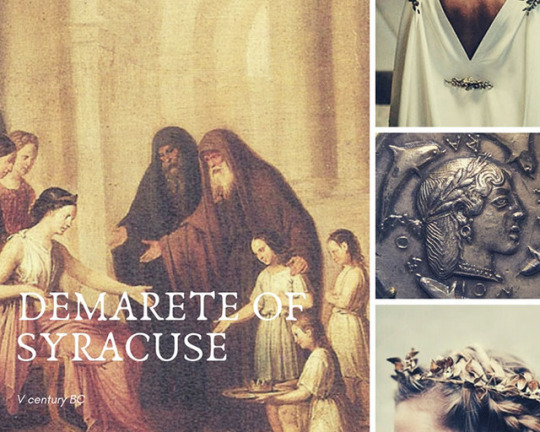
For when the ambassadors who had been dispatched from Carthage came to him [Gelon I of Syracuse] begged him with tears to treat them humanely, he granted them peace, exacting of them the expense he had incurred for the war, two thousand talents of silver, and requiring them further to build two temples in which they should place copies of the treaty. The Carthaginians, having unexpectedly gained their deliverance, not only agreed to all this but also promised to give in addition a gold crown to Damarete, the wife of Gelon. For Damarete at their request had contributed the greatest aid toward the conclusion of the peace, and when she had received the crown of one hundred gold talents from them, she struck a coin which was called from her a Damareteion.
Diodorus Siculus, The Library of History, book 11, 26
Demàrete (or Damàrete) was a V century BC Siceliot princess daughter of Theron, tyrant of Akragas (modern-day Agrigento). In order to get a powerful ally, Theron gave his daughter in marriage to Gelon, previously ruler of Gela (491 BC -485 BC) and starting 485 BC first tyrant of Syracuse. At the same time Theron married the daughter of Gelon’s younger brother, Polyzelus. According to the tradition, Demàrete had been started to the mysteries of Demeter of Kore in her youth. This means she was fluent in Greek and had a pure soul, blameless of any crime, as these were fundamental conditions for joining. The cult of Demeter and Kore was especially supported by the Siceliot ruling class as a way to integrate with the natives and obtain their consensus, as the two goddesses were in fact particularly loved by the locals. Moreover Herodotus states that the members of Gelon’s family (the Deinomenid) were ministering priests of the goddesses of the nether world.
Despite that very little is known about Demàrete’s life, her figure is linked to an extremely important event. In 480 BC a combined force led by Demàrete’s father and husband defeated the Carthaginian troops of Hamilcar the Magonid near Himera (in the area of modern-day Buonfornello, province of Palermo). The defeated Punics, deprived of a leader (Hamilcar died during the fight), begged for the victors’ magnanimity. Demàrete then interceded with her husband and obtained a clement treatment for the defeated. Her only request was the Carthaginians would have to stop sacrificing their children to the gods Baal and Tanit. Satisfied with the benevolent terms, the gratefully Punics donated to Demàrete a golden crown worthy of 100 talents as thanks to her mediation. To share the gift with her people, the noblewoman ordered to melt the crown and use the gold to mint a new coin, the demaréteion. This dekádrachmos (worthy of 10 drachms) is one of the few coins mentioned by ancient sources.
In 478 BC, two years after the battle of Himera, Gelon I died. He was succeeded by his brother Hiero I. His wife (whom Gelon had left his inheritance) and young unknown son were put into care of his other brother, Polyzelus, who will marry Demàrete. The couple was soon forced to leave Syracuse and took refuge at the court of the woman’s father, Theron. The new tyrant of Syracuse, Hiero I, didn’t in fact appreciate his brother’s influence over his people (increased after his marriage with Gelon’s widow). The war between Theron and Hiero to restore Polyzelus’ power was avoided thanks to the mediation of the poet Simonides. Followed the reconciliation between the two brothers and Polyzelus and Demàrete were finally able to return to Syracuse and restored to all their former honours. It is unknown when Demàrete died. As for Polyzelus he must have died before Hiero I since it was the youngest Deinomenid brother, Thrasybulus, to become the tyrant after Hiero’s death. Thrasybulus had convinced Gelon and Demàrete’s son to give up his claims over Syracuse. He would be overthrown by his own relatives after a couple of months and forced to go into exile to Epizephyrian Locris (near modern Capo Zefirio, southern Calabria). A democracy was established in Syracuse.
In 396 BC the Carthaginian general Himilco, at war with Syracusan tyrant Dionysius I, put the city under siege. He proceeded to raid the area called Akradina, which was situated outside the city’s walls. His troops destroyed the sanctuary of Demeter and Kore, built by Gelon I after the victory in Himera. Moreover they desecrated many burials and, among them, the ones of Gelon and Demàrete.
Even after death, the memory of Gelon and Demàrete would be dearly preserved. Hiero II, tyrant of Syracuse from 270 BC to 215 BC, will name two of his three children Gelon and Demàrete (the third being another daughter, Heraclea). It was an attempt to reconnect himself to Gelon I, from whom he declared to descend.
#women#history#women history#historical women#sicily#demarete of syracuse#gelon i of syracuse#theron of akragas#hiero i of syracuse#polyzelus of syracuse#thrasybulus of syracuse#dionysius i of syracuse#hiero ii of syracuse#himilco#greek sicily#siracusa#province of siracusa#myedit#historyedit#people of sicily#women of sicily
17 notes
·
View notes
Text
In Archimedes ‘The Sand Reckoner’, he attempted to count, using mathematical operations, the number of grains of sand it would take to fill the known universe.
It’s believed he lived around 300 BCE
"THERE are some, King Gelon, who think that the number of the sand is infinite in multitude; and I mean by the sand not only that which exists about Syracuse and the rest of Sicily but also that which is found in every region whether inhabited or uninhabited. Again there are some who, without regarding it as infinite, yet think that no number has been named which is great enough to exceed its multitude. And it is clear that they who hold this view, if they imagined a mass made up of sand in other respects as large as the mass of the earth, including in it all the seas and the hollows of the earth filled up to a height equal to that of the highest of the mountains, would be many times further still from recognising that any number could be expressed which exceeded the multitude of the sand so taken. But I will try to show you by means of geometrical proofs, which you will be able to follow, that, of the numbers named by me and given in the work which I sent to Zeuxippus, some exceed not only the number of the mass of sand equal in magnitude to the earth filled up in the way described, but also that of a mass equal in magnitude to the universe”
#math#mathematics#philosophy#greek philosophy#history#ancient history#history of thought#Archimedes#sand#reckoner#physics#geometry#astronomy
2 notes
·
View notes
Text
Stuff I Never Learned In Uni and Now I’m Gonna Sue:
When he was young, Plato used to wear a ridiculous earring and everybody made fun of him behind his back. Also his original name was Aristocles: ‘Plato’ (= Broady) is a nickname his trainer gave him because he was so stupidly buff.
Aristotle was fond of flashy clothes and flashier rings and spent ages doing his hair.
Socrates used to turn a stick into a pretend horse to amuse his children.
Alcibiades and his friends once got high on stolen Pythia’s herbs and risked the death penalty.
Plutarch literally said “Sex is nice, but have you tried reading Aristobulos?” (his books are now lost, btw, and that goes on my list ‘things to be furious and sad about’)
Empedocles, a vegetarian who won the Olympics, made an ox out of frankincense and myrrh and sacrificed it as a tribute to the gods instead of a real animal. Pythagoras also sacrificed an ox-shaped cake to the gods when he discovered that hypotenuse thing.
Sophist Anchimolus happily survived on figs and water, but people avoided him at the baths because he just stank so much.
Philoxenus and Gnathon the Sicilian used to blow their noses over the best dishes of a buffet, so that other guests wouldn’t eat them first.
The philosopher Crates was called ‘the Door-Opener’ because he had this habit of randomly walk into people’s houses and offer them unwanted and unsolicited advice.
Alcibiades once sent Socrates a gigantic cake for sex-related reasons, and Socrates’ wife was so mad she threw it on the floor and trampled it.
(As a reminder, Alcibiades tried everything he knew to get into Socrates’ pants but the guy just. never. shut. up. and Alcibiades would usually fell into a stupor and sleep.)
Many statues had little umbrellas on their heads so birds wouldn’t poop on them.
A guy once invited King Philip (Alexander’s dad) for dinner, but forgot kings usually travel with dozens of people. When Philip realized his host was embarrassed because there wasn’t enough food for everyone, he discreetly told his companions to leave room for cake. People ate very little in expectation of a glorious dessert, and so there was enough for everyone.
“Dreaming about cakes without cheese is a good omen, but cheesecakes signify deceit and trickery.” (Artemidorus, who totally wasn’t pulling things out of his own ass)
Proving nothing ever really changes and time is an illusion, Plutarch complained that the guides at Delphi would bore everyone to death by reading every single inscription while their audience baked in the sun.
“If a cucumber is bitter, just throw it away...Don’t go and complain Why do such things exist in this world?” (Marcus Aurelius, unproblematic fave; also filed under ‘does it spark joy?’)
Wine jars had a piece of wood inside it, so the mice who fell in could climb back out (a Most Civilised custom imo).
“Those drunk on wine fall on their faces; those drunk on beer fall on their backs.” (this from Aristotle, I dare hope from personal experience)
Empedocles once attended a party where the host told his guests they could either drink or be drenched in wine. The next day, he had the man executed. “This was the beginning of his career in politics”.
Alexander put collars on a number of deer to determine how long they lived. When they were caught, more than a hundred years later, they had not aged a day. (*stanning intensifies*)
A good method to stop children from crying: fasten a sponge on a jar of honey and give it to them. Probably also doubles as a good method for making their teeth fall out.
Several people tried to pass laws against children’s tantrums.
A flying pig once devastated the Ionic city of Clazomenae.
Greek divers had snorkels so they could stay longer underwater.
“The students nod to each other about charioteers, or mime-actors, or horses, or dancers, or about some gladiatorial fight; some just stand there like a block of stone, others pick their noses...Anything is preferable to paying attention to their teacher.” (Libanius, #bless; he also complained that students would rather handle snakes than touch their textbooks)
Aristotle made fun of Herodotus for saying a black man’s semen must also be black.
When Gelon, the future tyrant of Syracuse, was a boy, a wolf came into his classroom and stole his writing tablet. Gelon ran after him, and as soon as he’d stepped outside the school there was an earthquake: all the other children and their teacher died.
Archimedes once built a big-ass ship for king Hieron of Syracuse. It had a gymnasium, gardens, a library, a seawater pond full of fish and mosaics detailing the entire Iliad.
There was a rumor Sophocles died when he tried to recite his Antigone and couldn’t stop for breath because he never used commas. (#KarmaIsABitch)
In Sparta, all the girls and young men who were unmarried were locked together in a dark room. The men then grabbed a girl, and whoever they grabbed, they had to marry. Lysander, the famous Spartan general, was fined for abandoning the girl he caught and scheming to marry a prettier one.
Crocodile dung was considered an essential ingredient in face masks, but dishonest sellers would often present starling dung as crocodile’s.
There were beauty contests in several cities, both for men and for women. Some cities also held modesty contests for women.
The only valid reasons for being late at the Olmypics were illness, shipwreck and capture by pirates.
Pythagoras was shocked by how women lend each other clothes and jewelry without paperwork or a witness to the transaction.
Demosthenes refused to pay the prostitute Lais (a man) half a million dollars to sleep with him, declaring “I don’t buy regret at such a high price”.
Bald men made money by allowing people to break pots over their heads for fun.
In Southern Italy there was a breed of sheep whose wool was so valuable, shepherds put leather jackets on them so it wouldn’t be ruined by bushes and thorns.
The Gauls used to throw letters on funeral pyres so the dead could read them in their next life.
In Sparta, every year boys were whipped for an entire day on the altar of Artemis. Some died, but the ones enduring it most gracefully received the highest honors.
Plato once gave a public reading of his treatise On the Soul and Aristotle was the only person who stayed until the end.
The statues of unpopular politicians were thrown in the sea or turned into chamber pots.
Apsethus the Libyan trained some parrots to say ‘Apsethus is a god’, and the Libyans, impressed by the miracle, started to worship him. Then a Greek came along and trained the parrots to say ‘Apsethus put me in a cage and forced me to say Apsethus is a god’ so when the Libyans heard that, they seized Apsethus and burned him to death.
An idiot named Marcus insisted in running a race in full armour. He was so slow, at midnight the stadium authorities locked everything up because they mistook him for one of the statues. When they opened up again in the morning, they found he’d finished his first lap.
Athens was plagued with gangs of rich kids running around and stealing the offerings left for the gods. One of them was called The Hard Dicks.
Some many men died in the Peloponnesian War the city of Athens made polygamy legal. Euripides thus had two wives, but wasn’t happy with either of them.
A character in one of Euripides’ plays argued that wealth matters more than morality and the audience got so mad Euripides had to come on stage and beg them to wait for the end of the play - promising the guy would be revealed as the villain and meet a dreadful end.
When Rhodopis, a beautiful prostitute, was taking a bath, an eagle stole her shoe. It carried it all the way to Memphis and dropped it on the lap of Pharaoh Psammetichus, who immediately ordered the whole country to be searched for the owner of such a beautiful and shapely shoe. When Rhodopis was found, he married her.
In Elysium, the fortunate dead enjoy checkers, horse riding, gymnastics and playing the lyre.
[Source: various Greek authors, collected by J.C. McKeown in A Cabinet of Greek Curiosities. Also available: Ancient Medical Curiosties and Roman Curiosities.]
#ancient greece#greece#history#classics#antiquity#til#trivia#philosophy#athens and sparta#cinderella#cheesecake#aristotle#plato#euripides#so this book was a nice find#i left out a couple of ghost stories#but#i'll try to make that post about magic#later today
11K notes
·
View notes
Text
Continuation of the earlier post.
In the earlier post, I was talking about the great mathematicians of the world. In this post, I am gonna talk about - Archimedes and Pythagoras.
ARCHIMEDES
Archimedes was the most-famous mathematician and inventor in ancient Greece. Archimedes is especially important for his discovery of the relation between the surface and volume of a sphere and its circumscribing cylinder.He is known for his formulation of a hydrostatic principle (known as Archimedes’ principle) and a device for raising water, still used in developing countries, known as the Archimedes screw. Archimedes probably spent some time in Egypt early in his career, but he resided for most of his life in Syracuse, the principal Greek city-state in Sicily, where he was on intimate terms with its king, Hieron II. Archimedes published his works in the form of correspondence with the principal mathematicians of his time, including the Alexandrian scholars Conon of Samos and Eratosthenes of Cyrene. He played an important role in the defense of Syracuse against the siege laid by the Romans in 213 BCE by constructing war machines so effective that they long delayed the capture of the city. When Syracuse eventually fell to the Roman general Marcus Claudius Marcellus in the autumn of 212 or spring of 211 BCE, Archimedes was killed in the sack of the city.
TOP QUESTIONS
What was Archimedes’ profession? When and how did it begin?
What accomplishments was Archimedes known for?
What specific works did Archimedes create?
What is known about Archimedes’ family, personal life, and early life?
Where was Archimedes born? How and where did he die?
Study how turning a helix enclosed in a circular pipe raises water in an Archimedes screw
Study how turning a helix enclosed in a circular pipe raises water in an Archimedes screw
An animation of Archimedes screw.
Encyclopædia Britannica, Inc.
See all videos for this article
Far more details survive about the life of Archimedes than about any other ancient scientist, but they are largely anecdotal, reflecting the impression that his mechanical genius made on the popular imagination. Thus, he is credited with inventing the Archimedes screw, and he is supposed to have made two “spheres” that Marcellus took back to Rome—one a star globe and the other a device (the details of which are uncertain) for mechanically representing the motions of the Sun, the Moon, and the planets. The story that he determined the proportion of gold and silver in a wreath made for Hieron by weighing it in water is probably true, but the version that has him leaping from the bath in which he supposedly got the idea and running naked through the streets shouting “Heurēka!” (“I have found it!”) is popular embellishment. Equally apocryphal are the stories that he used a huge array of mirrors to burn the Roman ships besieging Syracuse; that he said, “Give me a place to stand and I will move the Earth”; and that a Roman soldier killed him because he refused to leave his mathematical diagrams—although all are popular reflections of his real interest in catoptrics (the branch of optics dealing with the reflection of light from mirrors, plane or curved), mechanics, and pure mathematics.
According to Plutarch (c. 46–119 CE), Archimedes had so low an opinion of the kind of practical invention at which he excelled and to which he owed his contemporary fame that he left no written work on such subjects. While it is true that—apart from a dubious reference to a treatise, “On Sphere-Making”—all of his known works were of a theoretical character, his interest in mechanics nevertheless deeply influenced his mathematical thinking. Not only did he write works on theoretical mechanics and hydrostatics, but his treatise Method Concerning Mechanical Theorems shows that he used mechanical reasoning as a heuristic device for the discovery of new mathematical theorems.
Get exclusive access to content from our 1768 First Edition with your subscription.
Subscribe today
His Works
There are nine extant treatises by Archimedes in Greek. The principal results in On the Sphere and Cylinder (in two books) are that the surface area of any sphere of radius r is four times that of its greatest circle (in modern notation, S = 4πr2) and that the volume of a sphere is two-thirds that of the cylinder in which it is inscribed (leading immediately to the formula for the volume, V = 4/3πr3). Archimedes was proud enough of the latter discovery to leave instructions for his tomb to be marked with a sphere inscribed in a cylinder. Marcus Tullius Cicero (106–43 BCE) found the tomb, overgrown with vegetation, a century and a half after Archimedes’ death.
sphere with circumscribing cylinder
sphere with circumscribing cylinder
The volume of a sphere is 4πr3/3, and the volume of the circumscribing cylinder is 2πr3. The surface area of a sphere is 4πr2, and the surface area of the circumscribing cylinder is 6πr2. Hence, any sphere has both two-thirds the volume and two-thirds the surface area of its circumscribing cylinder.
Encyclopædia Britannica, Inc.
Measurement of the Circle is a fragment of a longer work in which π (pi), the ratio of the circumference to the diameter of a circle, is shown to lie between the limits of 3 10/71 and 3 1/7. Archimedes’ approach to determining π, which consists of inscribing and circumscribing regular polygons with a large number of sides, was followed by everyone until the development of infinite series expansions in India during the 15th century and in Europe during the 17th century. That work also contains accurate approximations (expressed as ratios of integers) to the square roots of 3 and several large numbers.
On Conoids and Spheroids deals with determining the volumes of the segments of solids formed by the revolution of a conic section (circle, ellipse, parabola, or hyperbola) about its axis. In modern terms, those are problems of integration. (See calculus.) On Spirals develops many properties of tangents to, and areas associated with, the spiral of Archimedes—i.e., the locus of a point moving with uniform speed along a straight line that itself is rotating with uniform speed about a fixed point. It was one of only a few curves beyond the straight line and the conic sections known in antiquity.
On the Equilibrium of Planes (or Centres of Gravity of Planes; in two books) is mainly concerned with establishing the centres of gravity of various rectilinear plane figures and segments of the parabola and the paraboloid. The first book purports to establish the “law of the lever” (magnitudes balance at distances from the fulcrum in inverse ratio to their weights), and it is mainly on the basis of that treatise that Archimedes has been called the founder of theoretical mechanics. Much of that book, however, is undoubtedly not authentic, consisting as it does of inept later additions or reworkings, and it seems likely that the basic principle of the law of the lever and—possibly—the concept of the centre of gravity were established on a mathematical basis by scholars earlier than Archimedes. His contribution was rather to extend those concepts to conic sections.
Quadrature of the Parabola demonstrates, first by “mechanical” means (as in Method, discussed below) and then by conventional geometric methods, that the area of any segment of a parabola is 4/3 of the area of the triangle having the same base and height as that segment. That is, again, a problem in integration.
The Sand-Reckoner is a small treatise that is a jeu d’esprit written for the layman—it is addressed to Gelon, son of Hieron—that nevertheless contains some profoundly original mathematics. Its object is to remedy the inadequacies of the Greek numerical notation system by showing how to express a huge number—the number of grains of sand that it would take to fill the whole of the universe. What Archimedes does, in effect, is to create a place-value system of notation, with a base of 100,000,000. (That was apparently a completely original idea, since he had no knowledge of the contemporary Babylonian place-value system with base 60.) The work is also of interest because it gives the most detailed surviving description of the heliocentric system of Aristarchus of Samos (c. 310–230 BCE) and because it contains an account of an ingenious procedure that Archimedes used to determine the Sun’s apparent diameter by observation with an instrument.
Method Concerning Mechanical Theorems describes a process of discovery in mathematics. It is the sole surviving work from antiquity, and one of the few from any period, that deals with this topic. In it Archimedes recounts how he used a “mechanical” method to arrive at some of his key discoveries, including the area of a parabolic segment and the surface area and volume of a sphere. The technique consists of dividing each of two figures into an infinite but equal number of infinitesimally thin strips, then “weighing” each corresponding pair of these strips against each other on a notional balance to obtain the ratio of the two original figures. Archimedes emphasizes that, though useful as a heuristic method, this procedure does not constitute a rigorous proof.
On Floating Bodies (in two books) survives only partly in Greek, the rest in medieval Latin translation from the Greek. It is the first known work on hydrostatics, of which Archimedes is recognized as the founder. Its purpose is to determine the positions that various solids will assume when floating in a fluid, according to their form and the variation in their specific gravities. In the first book various general principles are established, notably what has come to be known as Archimedes’ principle: a solid denser than a fluid will, when immersed in that fluid, be lighter by the weight of the fluid it displaces. The second book is a mathematical tour de force unmatched in antiquity and rarely equaled since. In it Archimedes determines the different positions of stability that a right paraboloid of revolution assumes when floating in a fluid of greater specific gravity, according to geometric and hydrostatic variations.
Archimedes is known, from references of later authors, to have written a number of other works that have not survived. Of particular interest are treatises on catoptrics, in which he discussed, among other things, the phenomenon of refraction; on the 13 semiregular (Archimedean) polyhedra (those bodies bounded by regular polygons, not necessarily all of the same type, that can be inscribed in a sphere); and the “Cattle Problem” (preserved in a Greek epigram), which poses a problem in indeterminate analysis, with eight unknowns. In addition to those, there survive several works in Arabic translation ascribed to Archimedes that cannot have been composed by him in their present form, although they may contain “Archimedean” elements. Those include a work on inscribing the regular heptagon in a circle; a collection of lemmas (propositions assumed to be true that are used to prove a theorem) and a book, On Touching Circles, both having to do with elementary plane geometry; and the Stomachion (parts of which also survive in Greek), dealing with a square divided into 14 pieces for a game or puzzle.
Archimedes’ mathematical proofs and presentation exhibit great boldness and originality of thought on the one hand and extreme rigour on the other, meeting the highest standards of contemporary geometry. While the Method shows that he arrived at the formulas for the surface area and volume of a sphere by “mechanical” reasoning involving infinitesimals, in his actual proofs of the results in Sphere and Cylinder he uses only the rigorous methods of successive finite approximation that had been invented by Eudoxus of Cnidus in the 4th century BCE. These methods, of which Archimedes was a master, are the standard procedure in all his works on higher geometry that deal with proving results about areas and volumes. Their mathematical rigour stands in strong contrast to the ���proofs” of the first practitioners of integral calculus in the 17th century, when infinitesimals were reintroduced into mathematics. Yet Archimedes’ results are no less impressive than theirs. The same freedom from conventional ways of thinking is apparent in the arithmetical field in Sand-Reckoner, which shows a deep understanding of the nature of the numerical system.
In antiquity Archimedes was also known as an outstanding astronomer: his observations of solstices were used by Hipparchus (flourished c. 140 BCE), the foremost ancient astronomer. Very little is known of this side of Archimedes’ activity, although Sand-Reckoner reveals his keen astronomical interest and practical observational ability. There has, however, been handed down a set of numbers attributed to him giving the distances of the various heavenly bodies from Earth, which has been shown to be based not on observed astronomical data but on a “Pythagorean” theory associating the spatial intervals between the planets with musical intervals. Surprising though it is to find those metaphysical speculations in the work of a practicing astronomer, there is good reason to believe that their attribution to Archimedes is correct.

PYTHAGORAS
Pythagoras of Samos[a] (c. 570 – c. 495 BC)[b] was an ancient Ionian Greek philosopher and the eponymous founder of Pythagoreanism. His political and religious teachings were well known in Magna Graecia and influenced the philosophies of Plato, Aristotle, and, through them, Western philosophy. Knowledge of his life is clouded by legend, but he appears to have been the son of Mnesarchus, a gem-engraver on the island of Samos. Modern scholars disagree regarding Pythagoras's education and influences, but they do agree that, around 530 BC, he travelled to Croton in southern Italy, where he founded a school in which initiates were sworn to secrecy and lived a communal, ascetic lifestyle. This lifestyle entailed a number of dietary prohibitions, traditionally said to have included vegetarianism, although modern scholars doubt that he ever advocated for complete vegetarianism.
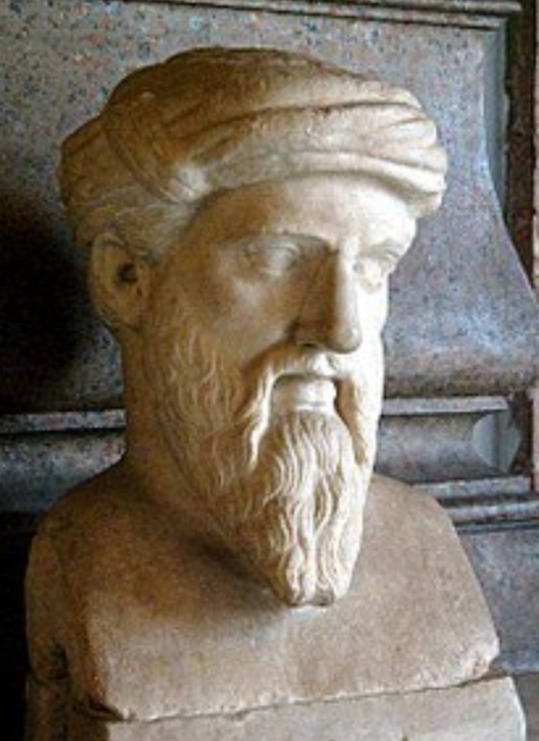
In the next post, I will be talking about ramanujan and shakuntala devi.
Follow me, stay tuned, next post will be uploaded soon.
1 note
·
View note
Text
@footnotestoplato asked me this but it deleted itself?? Anyyways:
1. ancient Greece or ancient Rome? Aaah i hate you for making me choose!! Erm, Ancient Greece for the art and culture and philosophy, Ancient Rome for the politics
3. which is your favourite Greek city-state? Syracuse:- the political turmoil and dichotomy of a benevolent dictator (Gelon) fascinates me, and the cultural richness attracting philosophers including Pindar and Simonides is interesting in such a volatile environment. Also all the Alexandrias. Because kudos to Alexander the Great for pinning his name on his success. (even though this makes him the ancient Trump in some ways)..
13. if you could time-travel to the classical world for a day, where would you go and why? Cicero’s house on the Palatine during his Consulship, stewing in the half light of the Senator’s study, watching the eyes’ weary lines as their owner revises the phraseology again and again, seeking my advice in the form of mock discourse, strengthening his position. He sits, a glass of wine in hand, stooped over his mahogany desk. Reading, rereading. Drafting his meteoric rise and setting the path for his fall.
3 notes
·
View notes
Text
Guide to Ancient Greek Coins of Sicily Examples on VIDEO
Ancient Coins of Sicily Explained in Video & Article
Learn about the rare Sicilian ancient Greek coins and the cities that struck them
youtube
https://www.youtube.com/watch?v=petOafNL7D0
A list of all the ancient Greek cities in Sicily which minted coins with examples of them.
The ancient Greek Island of Sicily has a variety of history and amazing coins to explore. Some of the cities had some of the rarest coins possible. The best standard reference work on the subject of these coins is Handbook of Coins of Sicily by Oliver D. Hoover. I cite coins from this book quite often, as HGC 2, (and the coin number). It is full of history and a variety of types not usually seen anywhere. I highly recommend it.
Over the years I have had a collection of thousands of ancient Greek and Roman coins that is over 13,000 items now. This inventory includes some very rare coins from many cities of Sicily.
Some common problems with rare ancient coins in general are:
People don’t know exactly what to search for.
There are limited amounts of ancient coins available.
There is not a lot of information that can help a beginner collect this series.
There is usually not one source that has many of the rare types available.
This article is to provide people with solutions to this issue. My name is Ilya Zlobin, and I am an expert, enthusiast, author and dealer in ancient Greek Roman Byzantine and even world coins and medals. The reason for this article is that I believe an educated customer is the best customer, as only someone that knows about a specific subject can appreciate the value and beauty of it. I have many articles and videos on many subjects, teaching about different ancient coins. It took me years of experience to have the inventory I have available for you to explore. When you deal with me, you are leveraging my vast experience of working with over 53,000 items over the years.
This article is full of links to the specific coins and cities and the coins shown here are ones available in my eBay store at the time of the writing of this article. You can use the links to search my store for the specific items, of which I have many. Some links may or may not yield results, but may in the future. So in other words you can use this list in order to put together a collection, or check back at later dates for certain cities. You city names are quite hard sometimes to spell so it is another way it is really helpful.
Click here to see all coins of ancient Sicily I have available.
A List of the Cities that Issued Coins in Ancient Sicily
This list of ancient Sicilian cities is comprehensive, including some of the super rare mints which are usually not seen. If you decide to put together a collection, you can click on each of the cities below of your interest and search my eBay store with over 14,000 items for those specific coins. You can also use the list below for your own searches.
Abakainon
Adranon
Agyrion
Aitna
Akragas
Akrai
Alaisa Aitnai
Alaisa Archonidea
Alontion
Ameselon
Amestratos
Apollonia
Assoros
Ath Athl
Entella (“The Camp”)
Eryx
Galaria
Gela
Henna (Enna)
Herakleia Minoa
Herbessos
Herbita
Himera
Hipana
Hybla Megala (Hybla Geleatis)
Iaiton (Iaitia)
Imachara
Kainon
Kalakte (Kale Akte)
Kamarina
Katane
Kentoripai
Kephaloidion
Kimissa
Kronia
Leontinoi
Lilybaion
Longane
Megara Hyblaia
Menainon (Menaion)
Messana (Zankle) and the Mamertini
Morgantina
Motya
Mytistraton
Nakone
Naxos
Panormos (Sys)
Paropos
Petra
Piakos
Segesta (Egesta)
Selinous
Sergitaians
Solous
Sielane (Stiela)
Syracuse Kings: Agathokles (Agathocles) Hieron II, Philistis, and Gelon II Hieronymos
Tauromenion
Thermai Himeraiai
Tyndaris
The Tyrrhenians
The island of Lipara
or Explore all coins of Sicily
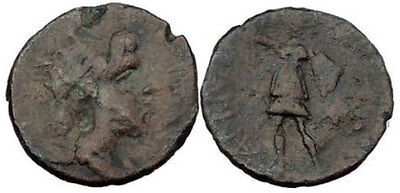
AITNA in SICILY after 210BC Ancient Greek City Coin Apollo Warrior i37922 Rare
Greek city of Aitna in Sicily Bronze 18mm (3.38 grams) after 210 B.C. Reference: Sear 1018 var. (three dot in field to left and head left); Calciati III, S. 148, Em. 8 Radiate bust of Apollo right, wearing chlamys. AITNAIΩN, Warrior standing facing, head right, holding spear and shield; three pellets in field to left.
The Syracusan colonists expelled from Katane in 461 B.C. founded a new settlement about ten miles to the north-west, ad to this place they transferred the name of Aitna which they had previously bestowed upon Katane.
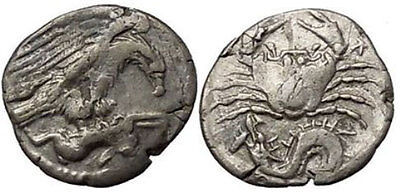
AKRAGAS in SICILY 420BC Hemidrachm Crab Hare Eagle Ketos Fish Silver Coin i40761
Greek city of Akragas in Sicily Silver Hemidrachm 15mm (1.84 grams) Struck circa 420-406 B.C. Reference: HGC 2, 105; SNG ANS 1010–3 Eagle standing right on hare; barley grain to left. Crab; below, ketos left with fish in its mouth.
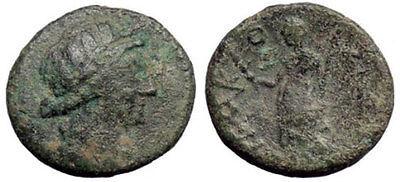
SICILY city AKRAI 210BC Underworld queen Demeter Cult Ancient Greek Coin i28403
Greek city of Akrai in Sicily Bronze 22mm (9.01 grams) After 210 B.C. Reference: Sear 1014; Calciati III pg. 37, 1; SNG ANS 902ff Wreathed head of Persephone right. AKPAIΩN, Demeter standing left, holding torch and sceptre.
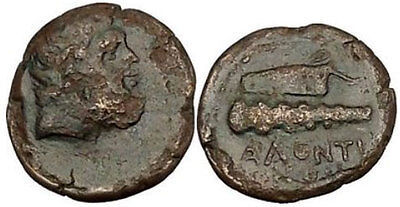
ALONTION in SICILY 400BC Hercules Club Quiver Ancient Greek Coin i41711
Greek city of Alontion in Sicily Bronze 15mm (2.63 grams) Struck circa 400 B.C. Reference: CNS 6; SNG ANS 1193 Bearded head of Hercules right. ΑΛΟΝΤΙNON, Club and quiver.
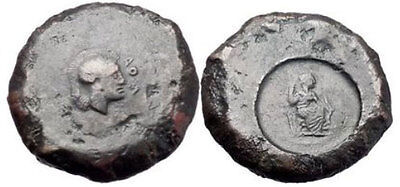
Athl / Atl / AΘA Mint in SICILY Rare 340BC Athena Rare Ancient Greek Coin i47252
Greek city or town Athl / Atl / AΘA Mint in Northwestern Sicily Bronze 30mm (26.95 grams) Struck circa 340-330 B.C. Reference HGC 2, 232; CNS III, p. 287, no. 1 AΘA, Head of Athena in Attic helmet right. Female figure enthroned right, holding palm branch or scepter and grounded bow; all within incuse circle.
Numismatic Note: This mint’s name has been previously misread as AΘΛ (Athl), in light of modern numismatic scholarship, AΘA is actually a Doric abbreviation for Athena. So therefore, the name of this mint is unknown. What is known is that the larger bronzes were re-struck on Syracusan issues from the period of 375-345 B.C.

ERYX Sicily 400BC Female & Crab Rare Authentic Ancient Greek Coin i28255
Greek city of Eryx in Sicily Bronze 11mm (1.56 grams) Struck circa 400-330 B.C. Reference: Calciati I pg. 288, 28 var.; Gabrici pg. 131, 46-48 Female head right. Crab.
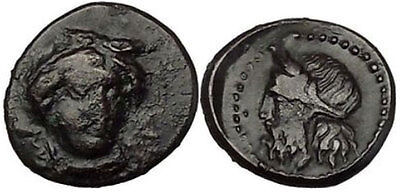
Gela in Sicily 339BC Rare Ancient Greek Coin Demeter River god Gelas i41739
Greek city of Gela in Sicily Bronze 15mm (2.90 grams) Struck circa 339-310 B.C. Reference: Sear 1099; Jenkins 549; B.M.C. 2.77-8 ΓΕΛΩΙΩΝ, Head of Demeter three-quarter face to right, wreathed with corn. Bearded head of river-god Gelas left, horned, and wreathed with horn.
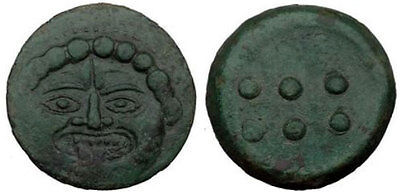
HIMERA Greek city in SICILY 420BC Hemilitron Large Ancient Coin Gorgon i37118
Greek city of Himera in Sicily Bronze Hemilitron 24mm (15.98 grams) Struck circa 450-420 B.C. Reference: Sear 1105; B.M.C. 2.,p.39,27-30 Gorgon’s head facing. Six pellets.
Numismatic Note: Fantastic coin in the most fantastic condition you can find, especially such a rarity!
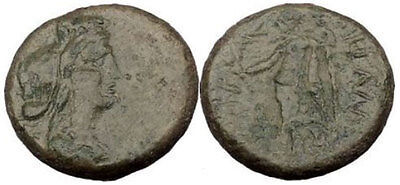
Hybla Megala in Sicily 210BC Hyblaia Modius Dionysus Panther Greek Coin i38058
Greek City of Hybla Megala in Sicily Bronze 19mm (7.30 grams) After 210 B.C. Reference: Sear 1115; Calciati III pg. 41, 1; SNG ANS 195ff Veiled head of Hyblaia right, wearing modius; behind, bee. ΥΒΛΑΣ ΜΕΓΑΛΑΣ, Dionysus standing left, holding kantharos and scepter, panther leaping up at feet.
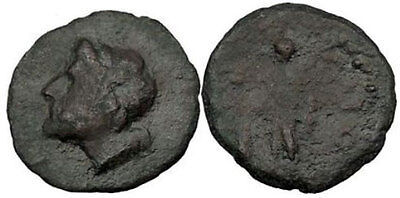
Iaitia in Sicily 241BC Zeus Hercules Authentic Ancient Greek Coin RARE i38057
Greek City of Iaitia in Sicily Bronze 17mm (2.26 grams) After 241 B.C. Reference: BMC – . SNG Cop. 333 var. SNG ANS – . SNG München – . Calciati I, S. 384, 6 Laureate head of Zeus left. IAITOY, Hercules
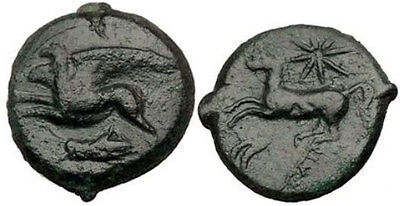
Alaisa “Kainon” in Sicily 360BC Rare Ancient Greek Coin Griffin Horse i43976
Greek city of Alaisa ” Kainon” in Sicily Bronze 23mm (8.72 grams) Struck 360-340 B.C. Reference: Calciati I pg. 252, 10; SNG ANS 1175ff Griffin running left; grasshopper below. Horse prancing left, reins loose; star above, KAINON in exergue.
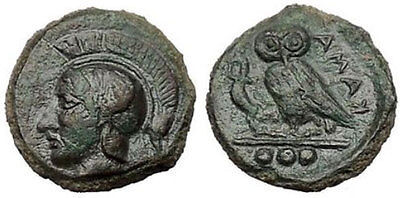
Kamarina in Sicily 413BC Authentic Ancient Greek Coin OWL Athena i46586
Greek city of Kamarina in Sicily Bronze Trias 15mm (3.36 grams) Struck 413-405 B.C. Reference: Sear 1063; B.M.C. 2.40 Head of Athena left, in crested helmet ornamented with wing. KAMA – Owl standing left, head facing, holding lizard in right claw; in exergue, three pellets.
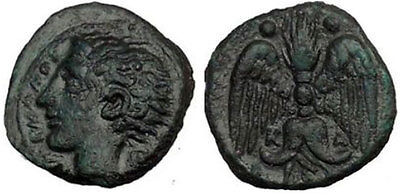
Katane in Sicily 413BC Ancient Greek Coin River god Winged thunderbolt i37312
Greek city of Katane in Sicily Bronze 12mm (1.93 grams) Struck 413-404 B.C. Reference: Sear 1067; Gabrici (La monetazione del bronzo nella Sicilia antica), pl. 2,7 AMENANOΣ, Horned head of young river-god Amenanos left. Winged thunderbolt dividing small K – A.
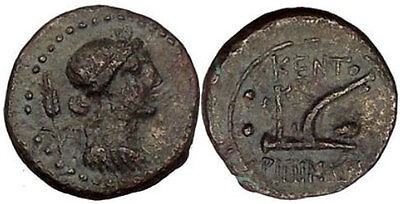
Kentoripai (Centuripae) in Sicily 211BC Ancient Greek Coin Demeter Plough i41811
Greek city of Kentoripai (Centuripae) in Sicily Bronze Hexas 17mm (3.95 grams) Struck 211-200 B.C. Reference: Sear 1084; B.M.C. 2.15; SNG Lloyd 928; Calciati 7; Campana 5 Bust of Demeter right, wreathed with corn; behind, tripod. KENTOPIПINΩN, Plough right, bird right on the share; two pellets in field to left.
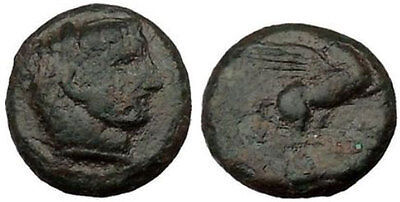
Kephaloidion in Sicily 344BC Ancient Greek Coin Pegasus winged horse i36972
Greek city of Kephaloidion in Sicily Bronze 13mm (2.26 grams) Struck 344-336 B.C. Reference: Calciati pg. 371, 3; SNG ANS -. Head of Hercules right, wearing lion’s skin headdress. Pegasus flying right.
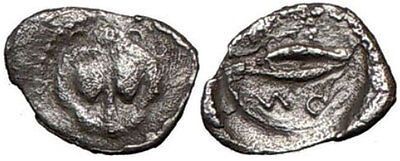
LEONTINOI in SICILY 475BC Lion Corn grain Ancient Silver Greek Coin i18500
Greek city of Leontinoi in Sicily Silver Obol 12mm (0.49 grams) Struck 475-466 B.C. Reference: Sear 828; B.M.C. 2.19 Lion’s head facing. ΛEON – Corn-grain.
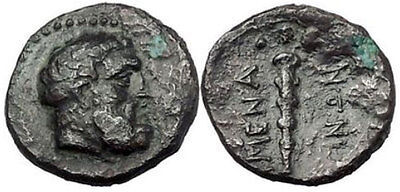
MENAINON in SICILY 2ndCenBC Hercules Club QUADRANS Ancient Greek Coin i46600
Greek city of Menainon in Sicily Bronze Quadrans 17mm (2.64 grams) Struck late 2nd Century B.C. Reference: HGC 2, 763; CNS III, pp. 188-189, nos. 12-12/6 Bearded head of Hercules right. MENAINΩN, club; mark of value, three pellets below.
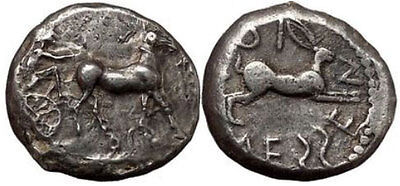
MESSANA in SICILY 480BC Tetradrachm Rare Silver Greek Coin Hare Chariot i40765
Greek city of Messana in Sicily Silver Tetradrachm 26mm (17.38 grams) Struck circa 480-461 B.C. Reference: SNG München 363 var.; Caccamo Caltabiani 218, 97 var.; Randazzo 59, 162 var. Charioteer driving biga of mules right; leaf in exergue. ΜΕSSΕ-N-ΙΟ-N, Hare springing right.
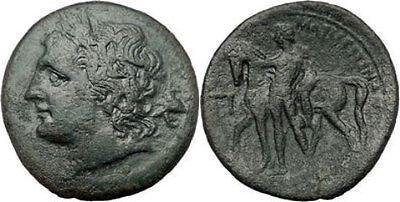
Messana in Sicily under Mamertini 220BC Greek Coin Ares Cult Dioskouros i46604
Greek city of Messana in Sicily under the name of Mamertini “Sons of Mars” Bronze Pentonkion 27mm (10.14 grams) Struck circa 220-200 Reference: Sear 1143; B.M.C. 2. 32 Laureate head of Ares left. MAMEPTINΩN – Horseman (Dioskouros) standing left, holding spear and touching the head of his horse standing left behind him; Π in field to left.
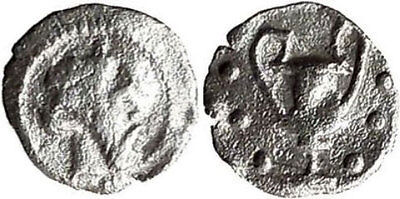
NAXOS in SICILY 461BC Silver Hexonkian Dionysus Kantharos Greek Coin i38811
Greek city of Naxos in Sicily Silver Hexonkion – Hemilitron 8mm (0.18 grams) Struck circa 461-430 B.C. Reference: Cahn 97 var. (V64/R– [unlisted rev. die]); Campana 12; Rizzo –; SNG ANS (Part 5) 1360 (same obv. die); SNG Lloyd –; SNG München –; Weber 618
Head of Dionysus right, wearing ivy wreath. Kantharos; six pellets around (mark of value).
Very rare.
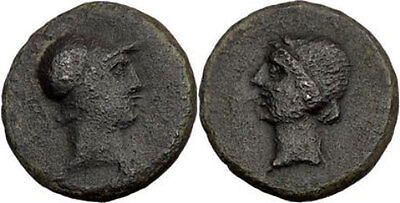
PANORMOS in SICILY 3rdCenBC Athena Persephone R1 Ancient Greek Coin i43658
Greek city of Panormos in Sicily Bronze 23mm (9.99 grams) Struck late third-early second centuries B.C. Reference: HGC 2, 1065 (R1); CNS I, pp. 331-332, nos. 12-12/6 ΠΑΝΟΡ/ΜΙΤΑΝ, Head of Athena in Corinthian helmet right. Head of Persephone left, werated with grain.
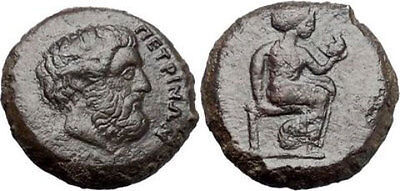
PETRA in SICILY 340BC Zeus Aphrodite RARE Authentic Ancient Greek Coin i47250
Greek city of Petra in Sicily Bronze 32mm (34.09 grams) struck circa 340-330 B.C. Reference: HGC 2, 1097 (R2); CNS III, p.317, no. 1 ΠΕΤΡΙΝΩΝ, Head of bearded Zeus right. Aphrodite enthroned right, holding dove.
Not much is known about the settlement, although it could be believed it was fortified as it’s name translates to ��the Rock”. Numismatic evidence locates the city to have been located in the area of northwestern Sicily, and that it was founded before circa 350 B.C. The city gave itself over to Roman control in 254 B.C. during the First Punic War. The community survived until the second century A.D.
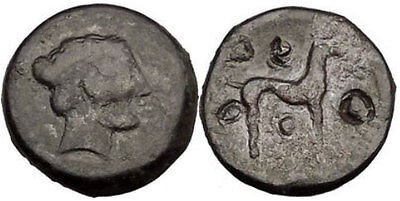
SEGESTA in SICILY 410BC Hound Dog Authentic Ancient Greek Coin i43985
Greek city of Segesta in Sicily Bronze Triantes 19mm (7.95 grams) Struck 410-400 B.C. Reference: HGC 2, 1181 Head of Aigiste right, wearing sphendone. Hound standing right, four round punched value marks around.
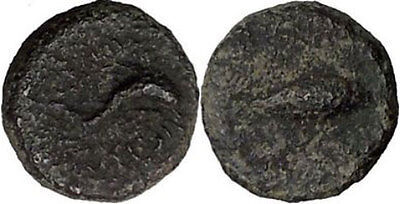
Solus in Sicily 2ndCenBC Dolphin Tuna Fish Authentic Ancient Greek Coin i43653
Greek city of Solus in Sicily Bronze 12mm (2.17 grams) Struck late second-early first centuries B.C. Reference: HGC 2, 1269 (R3); CNS I, p. 312, no. 17 COΛΟΝ/ΤΙΝWΝ, dolphin leaping right. Tuna swimming right.
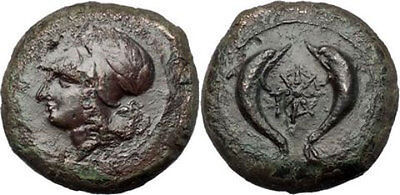
Syracuse in Sicily 344BC Timoleon Ancient Greek Coin Athena Dolphins i46625
Greek city of Syracuse in Sicily Time of Timoleon Bronze Litra 30mm (31.71 grams) Struck 344-336 B.C. Reference: Sear 1189; B.M.C. 2. 287 ΣΥΡΑ, Head of Athena left, wearing Corinthian helmet bound with olive-wreath. Starfish between two dolphins.

Syracuse in Sicily AGATHOKLES 317BC Persephone Bull Dolphins Greek Coin i46589
Greek city of Syracuse in Sicily Agathokles ( Agathocles)- Tyrant of Syracuse 317-289, King of Sicily 304-289 B.C. Bronze 23mm (9.04 grams) Struck circa 317-310 B.C. Reference: HGC 2, 1444 ΣYPAKOΣIΩN, Head of Persephone left, wreathed with grain; symbol behind. Bull charging left; dolphin above and below; NK monogram above.
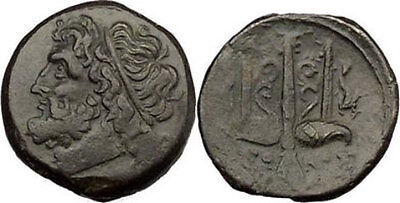
Syracuse Sicily 270BC King Hieron II Ancient Greek Coin Poseidon Trident i39151
Greek city of Syracuse in Sicily Bronze 20mm (7.13 grams) under king Hieron II, 270-215 B.C. Reference: Sear 1223; B.M.C. 2. 603 Head of Poseidon left, wearing tainia. Ornamented trident-head, between two dolphins, dividing IEPΩ – NOΣ.
0 notes
Text
Third Tyrant display at Long Beach
A rare doppio ducat of French King Louis XII as the Duke of Milan (1499-1512) is one of the many highlights of the $8 million “Tyrants of the Tyrrhenian and Adriatic Seas” exhibit at the September 2018 Long Beach Expo. (Photo courtesy Lyle Engleson/Goldberg Coins & Collectibles)
More gold and silver coins from the Tyrant Collection – ranging from Gelon, tyrant of the cities of Gela and Syracuse in 485 B.C.E., to King Victor Emmanuel III in 1933 – will be displayed together for the first time Sept. 6-8, 2018.
“Tyrants of the Tyrrhenian and Adriatic Seas” will be a featured attraction at the September 2018 Long Beach Coin, Currency, Stamp & Sports Collectible Expo in Long Beach, Calif.
There are 365 historic coins in the $8 million display, which celebrates numismatic treasures from Sicily on the south to Turin on the north. The exhibit is divided into regions by their boundaries with bodies of water, such as the Arno and Po rivers as well as the Adriatic and Tyrrhenian seas, and showcases some exceedingly rare issues.
“This part of the extensive Tyrant Collection, the world’s most valuable rare coin collection in private hands, encompasses the expansive area that evolved into modern Italy. The impressive coins in the exhibit range from frequently seen ancients to medieval and modern issues of great rarity,” said Ira Goldberg, president of Goldberg Coins and Collectibles, Inc. (www.GoldbergCoins.com) in Los Angeles, Calif. Goldberg is one of the numismatic professionals providing guidance in assembling the wide-ranging collection.
“It is a massive collection that vividly depicts the generations of rulers who held sway in their respective regions of old Italy,” said Bruce Lorich, who cataloged the exhibit.
Among the many high-quality rarities in the display are gold ducats and zecchino of the Venetian doges, including Giovanni Dandalo, Giovanni I. Corner and Francesco Contarini, as well as a doppio ducat of the French King Louis XII when he was the Duke of Milan from 1499 until his death in 1512. The Venetian gold ducat collection is complete, and the exhibit features the only complete set in private hands of every doge of Venice who struck a gold ducat.
Also on display will be this historic gold zecchino (1625-1629) of the Venetian Doge, Giovanni I. Corner, which depicts him kneeling while being blessed by Mark, the patron saint of Venice, and depicts Christ on the back giving a benediction. (Photo courtesy Lyle Engleson/Goldberg Coins & Collectibles)
The extensive array of Sicilian coins in the Tyrants of Charybdis section of the exhibit includes an ancient gold 100 litrae of Dionysios I and a rare gold 1727 4 ducati of Carlo III of Palermo.
This is the third display in a multi-year series planned by the anonymous owner. Detailed catalogs will be available at the show for $10.
This article was originally printed in World Coin News. >> Subscribe today.
If you like what you’ve read here, we invite you to visit our online bookstore to learn more about Standard Catalog of World Coins, 1601-1700.
Learn more >>>
The post Third Tyrant display at Long Beach appeared first on Numismatic News.
0 notes
Photo
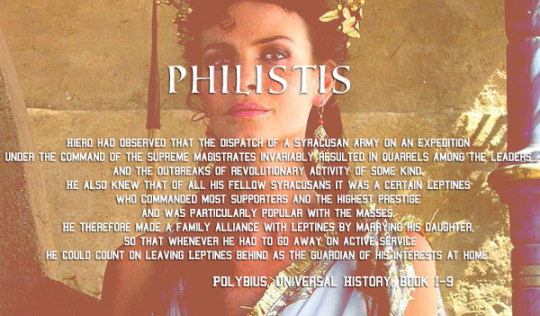


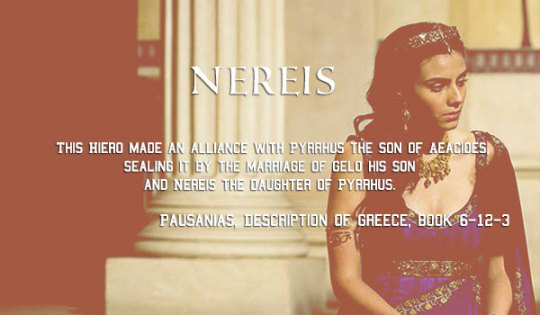
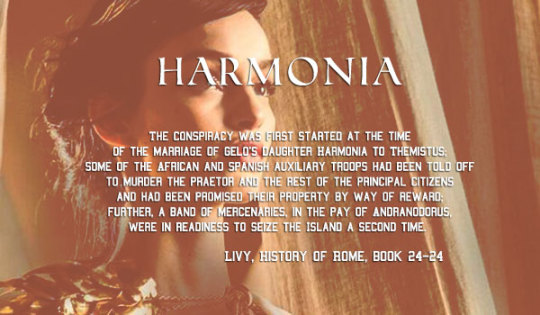
"For what," he [the praetor Sopater] asked, "could a boy like Hieronymus, who was hardly in his teens, have done on his own initiative? His guardians and masters reigned unmolested because the odium fell on another; they ought to have perished before Hieronymus or at all events when he did. [...] But it was really the wives who were responsible and who, being of royal blood, had filled their husbands with a passion for royalty, for one of the men had married Hiero's daughter, the other a daughter of Gelo." At these words shouts rose from the whole assembly declaring that neither of these women ought to live, and that no single member of the royal family ought to survive.
Livy, History of Rome, book 24-24
The Women of the House of Hiero II of Syracuse (3rd century BC)
Philistis was the daughter of an influential Syracusan citizen, Leptines. Through her father, she descended from Siceliot historian Philistus. Around 275 BC Philistis married Hiero, who will become tyrant of Syracuse in 270 BC. This man was the illegitimate son of a Syracusan nobleman, Hierocles. Hiero served under Pyrrhus I of Epirus during the Sicilian campaign, and after the King of Epirus left the Island, Hiero was appointed arcontes together with another man, Artemidorus. While the latter, at some point, simply disappeared from the chronicles, Hiero managed to establish a personal rule resembling the contemporary Hellenistic reigns. Philistis would give birth to three children: Gelo, Demarata and Heraclia. Nothing more is known about her life or death, although she’s portrayed in various coins minted during the reign of her husband. In these coins Philistis appears veiled and with idealized traits, resembling the type of Demeter, but also in the style of the coins of the Ptolemaic queens of Egypt.
Demarata was daughter of Hiero II and Philistis. Her name was chosen to honor late queen Demarete of Syracuse and in an attempt to link Hiero’s dinasty to previous tyrant Gelon’s, from whom Hiero declared to descend. Demarata married Adranodoros, one of Hieronymus’ fifteen guardians and part of the pro-Carthaginian faction. Hieronymus was Hiero’s grandson and heir as well as Demarata’s nephew and became Syracuse’s tyrant after his grandfather’s death in 215 BC. Taking advantage of his nephew’s young age (he was 15 at that time), Adranodoros concluded an alliance between Syracuse and Carthage, thus betraying Rome. Moreover he dismissed the other guardians and became Hieronymus’ sole ward with the title of chief counsellor. Hieronymus was killed (stabbed to death) in 214 BC in Leontini by a band of conspirators led by the Syracusan Deinomenes. He had ruled for just 13 months. At first, Adranodoros attempted to seize the power and become the new tyrant. When he understood it was too difficult and risky, he surrendered the power to the Syracusan people and was appointed general. But soon the people became wary of Adranodoros, especially after Ariston, a comedian and friend of the general, declared that Adranodoros and Themistos (brother-in-law of the late Hieronymus) were plotting to massacre the other influential citizens to establish their personal tiranny. Syracusan senate then gave order to eliminate the threat and so Adronodoros and Themistus were killed as soon as they entered the Senate building in 214 BC. Not satisfied with just those two murders and with the intent to justify his decision, the other general Sopater (member of the pro-Roman faction) accused the two men’s wives. In particular, Demarata was depicted as ambitious and power-hungry. She was accused of being the real mastermind behind the idea to remove Hieronymus’ other guardians, as a matter of fact starting Adranodoros’ scramble for power. Demarata’s supposed (or not) aspiration to become Syracuse’s queen was shattered the moment she was killed by the angry mob incited by Sopater’s accusations.
Heraclia was daughter of Hiero II and Philistis, as well as sister of Demarata and Gelo. She married Zoippus, who together with Adranoros was one of his nephew Hieronymus’ guardians. Like his brother-in-law, Zoippus was part of the pro-Carthaginian faction and worked to distance Syracuse from Rome. He was sent to a diplomatic mission to Ptolemy (most certainly Ptolemy IV Philopator). When in 214 BC Zoippus was reached by the news of Hieronymus’ death, he decided to remain in Alexandria in a self-imposed exile and so he survived his family’s massacre. His wife, Heraclia, and his two unnamed daughters weren’t equally lucky. No importance was given to the fact they were extraneous of plots and political schemes, what mattered was they were members of the royal family. They seeked refuge in a temple, hoping the mob would have respected the sacrality of the place. Heraclia implored the crowd to at least spare the girls, who were so young and innocent and just kill her. She was dragged outside the temple and killed before her daughters’ eyes with her blood splattering them. The girls, at first, managed to resist, but in the end they fell lifeless to the ground with their bodies full of wounds and whole place was covered in their blood. Soon after a messenger arrived with the order they were not to be killed, but it was already too late.
Nereis was an Epirote princess and the daughter of Pyrrhus II of Epirus and an unnamed woman. Her sister Deidameia was the last Aeacid sovereign of Epirus. Nereis descended from both Pyrrhus I of Epirus (her great-grandfather) and the Syracusan tyrant Agathocles (her great-great-grandfather). Her marriage to Gelo, Hiero’s son, was part of her father-in-law’s policy to strenghten and validate his dynasty. A similar alliance had been established in the past, and Nereis was the result of it. The marriage pact was concluded just before the fall of the Aeacid dynasty. The princess bore at least two children to Gelo, a girl and a boy: Harmonia and Hieronymus. Nothing is known about her fate, but it’s implied she survived her sister, making Nereis the last surviving Aeacid royal member.
Harmonia was the only daughter of Gelo of Syracuse and Nereis of Epirus. This made her the granddaughter and then the sister of the last two Syracusan tyrants. She married Themistos, member of the pro-Carthaginian faction and possibly one of the 15 guardians of Hieronymus. Themistos was accused together with Adranodoros to aspire to a personal tyranny following the murder of his brother-in-law and then killed. Like her aunt Demarata, Harmonia was considered a schemer and a puppetmaster of both her husband and young brother. After the murders of her aunts and cousins, it was only a matter of time Harmonia would have followed them. Her nurse then found a girl of the same age and resembling her protegée. The girl accepted to pass off the princess and was dressed in royal attire by the nurse, then she proceded to draw all the attention to her. In the meantime, Harmonia went hiding, but seeing the murderous crowd killing the innocent girl was too much for the princess. Tradition says she killed herself, although according to Valerius Maximus she revealed herself in front of the killers, claiming to be the real Harmonia, and was instantly murdered.
#women#history#women history#historical women#sicily#Philistis#Demarata#Heraclia#Nereis#Harmonia#hiero ii of syracuse#hieronymus of syracuse#greek sicily#people of sicily#women of sicily#siracusa#province of siracusa#historyedit#myedit
65 notes
·
View notes